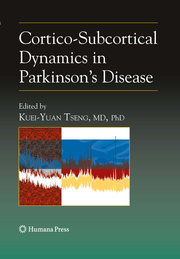Detailansicht
Cortico-Subcortical Dynamics in Parkinsons Disease
Contemporary Neuroscience
ISBN/EAN: 9781617378836
Umbreit-Nr.: 1803592
Sprache:
Englisch
Umfang: x, 316 S., 76 s/w Illustr., 316 p. 76 illus.
Format in cm:
Einband:
kartoniertes Buch
Erschienen am 19.11.2010
Auflage: 1/2010
- Zusatztext
- The striatum is the principal input structure of the basal ganglia. Numerically, the great majority of neurons in the striatum are spiny projection neurons, which produce the inhibitory output of the striatum to the globus pallidum and substantia nigra. The major glutamatergic afferents to the striatum from the cerebral cortex make monosynaptic contact with spiny projection neurons. The dopaminergic afferents from the substantia nigra also synapse directly on the spiny projection neurons. Thus, the spiny projection neurons play a crucial role in the input-output operations of the striatum by integrating glutamatergic cortical inputs with dopaminergic inputs and producing the output to other basal ganglia nuclei. Anatomical observations made nearly 30 years ago suggested that inhibitory interactions among the spiny projection neurons of the striatum are very pr- able. Individual spiny projection neurons produce a local axonal plexus in the spheroidal space occupied by their own dendritic trees [1, 2]. Based on the GABAergic nature of these neurons and their synaptic contacts with other spiny neurons, several authors have proposed that the spiny projection neurons form a lateral inhibition type of neural network [3-5]. In the idealised concept of lateral inhibition, each output neuron makes inhibitory synaptic contact with its neighbours [5]. However, there are physical limitations set by the extent of axonal and dendritic trees, and the number of synaptic sites, which mean that lateral inhibition is limited to a local domain of inhibition.
- Kurztext
- Cortico-subcortical dynamics in Parkinson's disease aims to integrate key pathophysiological aspects underlying Parkinson's disease. The volume offers a broad spectrum of opinions on how chronic dopamine depletion affects cortico-subcortical dynamics, especially how disruptions of the non-dopaminergic systems resulting from chronic dopaminergic degeneration could lead to the functional alterations observed in parkinsonism. About the Editor: Dr. Kuei Y. Tseng is Assistant Professor in the Department of Cellular and Molecular Pharmacology at Rosalind Franklin University of Medicine and Science, The Chicago Medical School, North Chicago, IL, USA.
